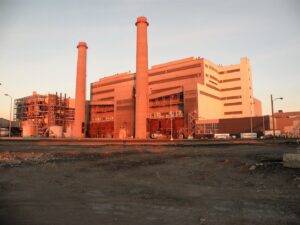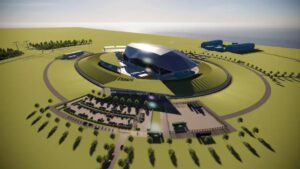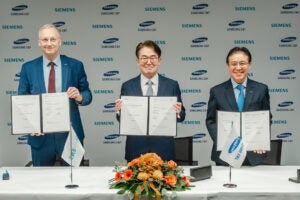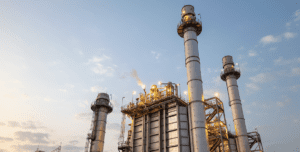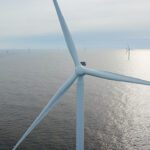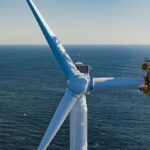 |
Winning POWER’s highest honor, South Fork Wind—the first commercial-scale offshore wind farm in U.S. federal waters—stands as a beacon for the power sector’s ambition to forge new industries in the face of adversity. Commissioned in July 2024 as offshore wind projects faltered nationwide, South Fork proved that labor, permitting, engineering, and grid integration can align to deliver complex infrastructure at scale. While the project lays out new bedrock for the nation’s carbon-free prospects, it offers the entire industry a proof point for resilience, technical rigor, and what it takes to build the next generation of power.
Awarding POWER’s highest honor is never easy. This year, the decision was especially fraught, as surging electricity demand collided with a volatile mix of policy reversals, brittle supply chains, and inflationary shocks that upended project economics across the global power sector. Even as the drumbeat to build cleaner, smarter, and more extensive infrastructure grew louder, utilities scrambled to shore up reliability, and developers recalibrated risk in real time. In 2025, the bar for excellence was defined by resilience under pressure, precision across disciplines, and the rare ability to deliver complex infrastructure amid mounting uncertainty.
Enter South Fork Wind, a 132-MW offshore wind farm anchored 35 miles east of Montauk Point, New York, developed by Danish energy giant Ørsted and utility Eversource under a joint venture (with infrastructure investor Global Infrastructure Partners acquiring Eversource’s stake in September 2024). Fully commissioned in July 2024, South Fork became the first utility-scale offshore wind project in U.S. federal waters, delivering clean power to approximately 70,000 Long Island homes under a pioneering 20-year power purchase agreement (PPA) with the Long Island Power Authority (LIPA), a municipal utility serving 1.2 million customers and responsible for Long Island’s electric transmission and distribution. The PPA averages 14.1¢/kWh, blending an initial 16¢/kWh for 90 MW and 8.6¢/kWh for an expanded 40 MW.
 |
|
1. South Fork Wind is a 12-turbine, 132-MW offshore wind farm powering 70,000 homes across Long Island, New York. Located 35 miles east of Montauk Point, the wind farm delivers power to the local substation in the Town of East Hampton through a series of transmission cable systems buried on the sea floor. Source: Long Island Power Authority |
Built atop fixed monopile foundations in waters up to 43 meters deep, the project transmits energy via a 68-nautical-mile subsea cable, landing at Wainscott Beach and connecting to the East Hampton substation (Figure 1). In November 2024, South Fork Wind achieved a 56% capacity factor, surpassing expectations for offshore wind performance in the region.
 |
|
2. Over its planned 30-year lifespan, South Fork Wind will be maintained by the ECO Edison—the first U.S.-built, U.S.-flagged, and U.S.-crewed offshore wind service operations vessel. Constructed by Edison Chouest across shipyards in Louisiana, Mississippi, and Florida, the vessel includes components sourced from 34 states and was built by more than 600 American workers. Courtesy: Ørsted |
But the project’s legacy extends far beyond these numbers. Over the course of its development, South Fork Wind set a new standard for American offshore wind with a series of extraordinary firsts. It features 12 Siemens Gamesa SG 11.0-200 DD turbines—the largest installed in U.S. waters to date. Its 1,500-tonne offshore substation, fabricated by Kiewit Offshore Services in Texas, is the first built domestically for a U.S. wind farm, while the ECO Edison (Figure 2), built in Louisiana, is the nation’s first U.S.-flagged, American-crewed offshore wind service vessel. The project’s 68-nautical-mile export cable, manufactured in South Carolina and installed via record-setting horizontal directional drilling beneath Wainscott Beach, preserved sensitive coastal ecosystems while linking the turbines to the East Hampton substation. South Fork also pioneered the full integration of IEC 61850 GOOSE protocol for grid control and implemented a hybrid protection and control architecture merging European and U.S. standards.
And, in a country where a mature offshore wind supply chain remains more aspiration than reality, South Fork Wind mobilized components, labor, and expertise from at least five states—stretching across 19 states for contracts and suppliers—creating more than 1,000 direct jobs and catalyzing nearly $1 billion in new investment. Its construction required forging new relationships with U.S. manufacturers, ports, and unions, and coordinating 173 supply chain contracts for everything from foundation fabrication in Rhode Island and substation assembly in Texas, to cable manufacturing in South Carolina and turbine assembly in Connecticut. Just as significant was the project’s navigation of an unprecedented regulatory landscape. South Fork Wind was notably the first U.S. offshore wind project covered by the federal Permitting Council’s FAST-41 program, which set a new bar for coordinated, transparent, and timely federal review.
Navigating Tumultuous Waters
In the decade before South Fork Wind came online, the world celebrated offshore wind as a rapidly expanding pillar of the global clean energy transition. Since Denmark’s pioneering 5-MW project in 1991, offshore wind capacity surged to 67.4 GW by 2023, led by China, the UK, and Germany. In 2023 alone, nearly 10 GW of new offshore wind capacity was added globally, with projections calling for annual installations to quadruple by 2030, reaching 156 GW worldwide. The U.S. long aspired to join that growth, eyeing energy security, economic sovereignty, and climate leadership, and to better position the nation to compete globally in offshore wind’s next phase of growth.
Yet, before South Fork, only 42 MW of offshore wind was operational: the 30-MW, five-turbine Block Island Wind Farm, developed by Deepwater Wind (now part of Ørsted) in Rhode Island, which has operated since 2016, and the 12-MW Coastal Virginia Offshore Wind (CVOW) pilot project, developed by Dominion Energy and fully operational by late 2020. Despite federal leasing momentum and state-level procurement targets—especially in New York, New Jersey, and Massachusetts—U.S. projects remained mired in permitting delays, litigation, inflationary cost pressures, and a fragile supply chain still in its infancy.
Between December 2023 and July 2024, the U.S. offshore wind sector’s challenges only intensified. Major projects like Ørsted’s Ocean Wind 1 and 2, totaling 2.4 GW off New Jersey, were canceled owing to soaring costs, inflation, and supply chain disruptions—Ørsted cited “macro-economic factors” as the cause. Similarly, Avangrid terminated PPAs for 1.8 GW of projects, and BP and Equinor restructured their Empire Wind joint venture after offtake negotiations failed. Overall, more than 12 GW of planned capacity was shelved or delayed, eroding sector confidence even more. As of mid-2025, the sector is cautiously rebounding, with new projects like Vineyard Wind 1 nearing completion, and state solicitations for more than 12 GW of capacity.
From Vision to Validation
South Fork Wind’s development officially began in 2013, when the Bureau of Ocean Energy Management (BOEM) awarded leases OCS-A-0486 and OCS-A-0487 to Deepwater Wind New England—the pioneering U.S. offshore wind firm behind Block Island—which at the time planned to advance a 3.3-GW portfolio offshore New York, southern New England, and the Maryland coast. In 2015, PSEG Long Island—a private utility under contract to manage LIPA’s grid—identified a looming reliability gap on Long Island’s South Fork, a space-constrained load pocket with 300 MW of peak demand and limited local generation. The utility projected that without new resources, costly transmission upgrades would be needed by 2022. To defer those upgrades and support New York’s Reforming the Energy Vision (REV) goals, LIPA in 2017 approved a 20-year PPA with Deepwater Wind South Fork—a 50/50 joint venture between utility Eversource and Deepwater Wind—to deliver energy, capacity, renewable attributes, and ancillary services from a 90 MW offshore wind farm, then planned as 15 GE turbines.
In 2018, buoyant on offshore wind’s expansion in the U.S., Ørsted acquired Deepwater Wind for $510 million to substantially expand its own burgeoning 5.5-GW U.S. offshore wind portfolio. The joint platform merged Deepwater’s “longstanding expertise in originating, developing, and permitting offshore wind projects in the U.S., and Ørsted’s unparalleled track-record in engineering, constructing, and operating large-scale offshore wind farms,” noted Martin Neubert, Ørsted’s CEO of Offshore Wind at the time.
As Martin Mogstad, head of Offshore Asset Management with Ørsted Americas, told POWER in June, Ørsted was bringing with it “30-plus years of global offshore wind leadership, including construction of the Block Island Wind Farm in Rhode Island, America’s first offshore wind project.” The location was key, he noted. “South Fork stems from our belief that offshore wind is a strategic domestic energy source for the northeastern U.S. This region has a world-class wind resource off its coast,” Mogstad said.
Permitting Pathways and Regulatory Firsts
Propelled partly by LIPA’s urgent need for energy resources, progress for the wind farm progressed swiftly. In August 2018, South Fork became the first U.S. offshore wind project to secure coverage under the federal Permitting Council’s FAST-41 program, a framework established by the 2015 Fixing America’s Surface Transportation Act to bring unprecedented coordination, transparency, and predictability to federal environmental reviews for major infrastructure.
Under FAST-41, agencies developed a comprehensive, public permitting timetable, with BOEM serving as lead. The project’s environmental review, which included a full environmental impact statement and extensive interagency collaboration, was completed in January 2022—about three and a half years after joining FAST-41. The process set an extraordinary regulatory precedent, demonstrating that complex, multi-jurisdictional offshore wind projects could be permitted on schedule and in compliance with evolving environmental standards.
 |
|
3. Commissioned in July 2024, South Fork Wind became the first commercial-scale offshore wind project in U.S. federal waters. Its 12 Siemens Gamesa turbines achieved a 56% capacity factor in their first winter of operation—demonstrating the technical maturity and performance potential of offshore wind power in American waters. Courtesy: Ørsted |
The feat is especially notable given that at least one permitting jurisdiction—Rhode Island Coastal Resources Management Council (CRMC)—led to a key condition: the project would be limited to no more than twelve turbines, each up to 11 MW, to minimize long-term impacts on sensitive glacial moraine and essential fish habitat at Cox Ledge. That prompted a configuration shift from up to 15 smaller turbines to 12 larger machines, mainly to allow the project to meet its contractual power obligations with LIPA while reducing the overall footprint. In July 2019, Ørsted and Eversource placed a conditional order with Siemens Gamesa for the SG 11.0-200 DD turbines (Figure 3). The companies formalized the technology switch as part of an updated Construction and Operations Plan submitted to BOEM.
“South Fork committed to space all of its turbines one nautical mile apart in a grid layout—the widest spacing of any offshore wind farm in the world—after consultation with multiple ocean user constituencies and federal agencies,” Mogstad explained. Environmental stewardship has been integral to South Fork Wind’s development, with comprehensive monitoring programs designed to assess and mitigate potential impacts on marine ecosystems, he noted. “This spring, our partner INSPIRE Environmental released new environmental data showing a ‘reef effect’ around South Fork’s turbine foundations, with diverse species thriving in the area,” he added. The data stems from a multi-year seafloor monitoring program, and it affirms that South Fork is delivering not just clean energy—but ecological benefits as well.
Scaling an Industry from Labor to Logistics
The next staggering task was to convene a workforce and supply chain to support the scale of the transformative project—and lay the groundwork for an enduring offshore wind industry. The effort ultimately spanned 19 states and created more than 1,000 jobs.
During construction, the project employed 350 workers at Kiewit’s Texas fabrication yard to build the 1,500-tonne offshore substation. Onsite, more than 100 local union electricians from the International Brotherhood of Electrical Workers (IBEW) and operators from the International Union of Operating Engineers (IUOE) installed the underground transmission cable. Union tradespeople—including ironworkers, pile drivers, commercial divers, electricians, and operating engineers—retooled their skills for offshore wind construction, working alongside engineers from Texas’s Gulf Coast oil and gas sector.
South Fork Wind’s domestic investments revitalized ports and factories nationwide. Rhode Island’s ProvPort produced foundation components; South Carolina’s Nexans facility manufactured the 68-nautical-mile export cables; and Connecticut’s State Pier marshalled turbine components. Louisiana’s Edison Chouest built the ECO Edison—the first U.S.-flagged offshore wind service vessel—while Texas’s Kiewit yard leveraged offshore oil-and-gas expertise for substation fabrication. Landlocked states contributed too: Kansas engineers designed control systems, and Ohio steel mills supplied monopile materials.
“Building South Fork Wind was never just about a single project—it was about creating a new American energy industry,” noted Mogstad. “The lessons learned at South Fork are already shaping the future. Ørsted’s Northeast construction program includes the Revolution Wind and Sunrise Wind projects and will add 1.8 GW of clean generating capacity by 2027—enough to power nearly 1 million homes.”
Engineering the Build: Anchoring Innovation
Despite the unprecedented scale, construction moved quickly. “Once we put the first ‘steel in the water’ in June 2023, it took about a year to fully construct South Fork Wind and bring it into commercial operation,” Mogstad said.
South Fork’s engineering began 120 feet below the Atlantic’s surface, where twelve 36-foot-diameter steel monopiles—each weighing 1,500 tons—were driven up to 295 feet into the seabed using a 4,000-kilojoule impact hammer. Bubble curtains and real-time monitoring limited noise to 216 dB RMS (decibels Root-Mean-Square)—a benchmark for marine protection. Above water, Siemens Gamesa SG 11.0-200 DD turbines rose 850 feet from sea level to blade tip. Each 11-MW turbine features a 200-meter rotor diameter and 97-meter blades, optimized for the Atlantic’s Class II wind regime. Their hybrid protection system merged IEC 61850 GOOSE protocol with ANSI standards, enabling fiberoptic grid communication embedded in the export line.
Central to the build was the Kiewit-built offshore substation, installed via Boskalis’ Bokalift 2. Inside, static synchronous compensator (STATCOM) harmonic filters and dynamic voltage control supported integration with Long Island’s fossil-dependent grid. The 138-kV infrastructure also future-proofed the system. The export cable, manufactured by Nexans, was laid by DEME’s Living Stone using a jet plow to bury it six feet beneath the seabed. At landfall, Michels Corporation executed a 2,589-foot horizontal directional drill beneath Wainscott Beach, preserving sensitive dunes and marshes.
 |
|
4. South Fork’s onshore substation required intricate coordination between Ørsted and HDR, with split protection systems and evolving philosophies. HDR implemented IEC 61850 GOOSE protocol, reduced copper wiring, and developed a shared asset register to align European and U.S. standards—laying the digital and physical foundation for reliable offshore grid integration. Courtesy: HDR |
South Fork Wind’s onshore substation also demanded intricate coordination and technical innovation (Figure 4). “The main control building at the South Fork onshore station is divided into two aisles of different stakeholder protection and control systems,” said HDR Systems Protection Lead Jaimeer Patel. “One set of panels was owned by Ørsted—designed by different suppliers like Hitachi Energy, Siemens Gamesa, and Ørsted’s engineering team—and the remaining panels were designed by HDR and owned by Eversource Energy at the time of commissioning. Evolving system protection/metering philosophies posed a unique challenge for our engineering team, requiring multiple revisions to the construction drawings while still meeting an aggressive timeline for delivery to the construction team.”
 Patel emphasized the extensive teamwork required: “Interconnecting Ørsted-owned panels with HDR-designed panel drawings for AC/DC [alternating current/direct current] supply feeds and control/indication/communication alarms/statuses via SCADA/HMI [supervisory control and data acquisition/human-machine interface] systems required regular collaboration.” Supply chain challenges added further complexity. “Multiple instances arose where an alternative solution (vendors/suppliers for the original proposed material or equipment) was provided due to long lead times or lack of availability. HDR developed a conservative estimate of preliminary cable lengths to reserve an ample quantity of cabling.”
Patel emphasized the extensive teamwork required: “Interconnecting Ørsted-owned panels with HDR-designed panel drawings for AC/DC [alternating current/direct current] supply feeds and control/indication/communication alarms/statuses via SCADA/HMI [supervisory control and data acquisition/human-machine interface] systems required regular collaboration.” Supply chain challenges added further complexity. “Multiple instances arose where an alternative solution (vendors/suppliers for the original proposed material or equipment) was provided due to long lead times or lack of availability. HDR developed a conservative estimate of preliminary cable lengths to reserve an ample quantity of cabling.”
To ensure reliability, HDR implemented IEC 61850 GOOSE protocol across 24 relay panels, enabling ultra-fast communication between offshore turbines and onshore controls. “IEC 61850 protocol trips and blocks the correct high voltage equipment at ultra-high messaging speed, establishing system reliability by publishing GOOSE messages to all imperative equipment in the same network,” Patel explained.
HDR also mapped IEC 81346 asset codes to ANSI/IEEE naming standards using a master register. “The naming nomenclature was required to align one-to-one with ANSI/IEEE device naming nomenclature standards used to design Eversource Energy-owned control panels and yard equipment. As part of this effort, a master asset register was required to be developed for the onshore components and fill in all the disconnects/gaps between two different protocols for equipment naming and tagging nomenclature at South Fork onshore substation.”
In addition, “Protection and control element designs were executed based on the system feasibility study performed for the entire project from offshore to onshore station ends, and to the point-of-interconnection to a PSEG substation. An extensive collaborative effort was required to cover all the blind spots and address any relay protection and communication issues between the two ends,” said Patel. The goal, he noted, was to ensure consistent, high-speed response across a multi-jurisdictional system—without gaps that could compromise grid reliability..
The Key to Success: Building Consensus, Engineering Trust
While South Fork remains an extraordinary testament to the viability and benefits of setting out to build with vision, Mogstad noted its success reflects years of public engagement, political support, and labor-backed momentum. “South Fork Wind is a model of how to build public consensus around transformative energy projects,” he said. “Over many years of planning, permitting, and construction, the project earned strong bipartisan support on Long Island and in its host community of East Hampton, New York. Open, consistent communication with the community has been central to its success, ensuring concerns were heard and addressed. New York state has been a key partner, demonstrating national leadership advancing offshore wind energy.”
From an engineering standpoint, HDR’s Patel called South Fork a reference point for future projects. “As the first utility-scale offshore wind project in the U.S., many experiences can be used to mitigate challenges on the next wave,” he said. Success, he noted, demands early alignment on developer requirements, rigorous document control, and constant stakeholder collaboration. “A multicast communication approach is essential to avoid blind spots and ensure the right teams can quickly resolve issues as they arise,” he said.
For now, South Fork stands as proof of what is possible. “Offshore wind is essential to meet rising energy demands, especially in the land-constrained Northeast,” Mogstad said. A recent report from Aurora Energy Research, he noted, identified offshore wind as the only large-scale generation capacity on track for near-term deployment in downstate New York, making it critical to meeting widening reliability needs. “Commercial-scale offshore wind projects are under construction today from Massachusetts to Virginia, rooted in the success of South Fork Wind. Its legacy lies not just in the turbines powering homes in Long Island, but in the foundation it has laid for this new American energy industry.”
—Sonal Patel is a POWER senior associate editor (@sonalcpatel, @POWERmagazine).


